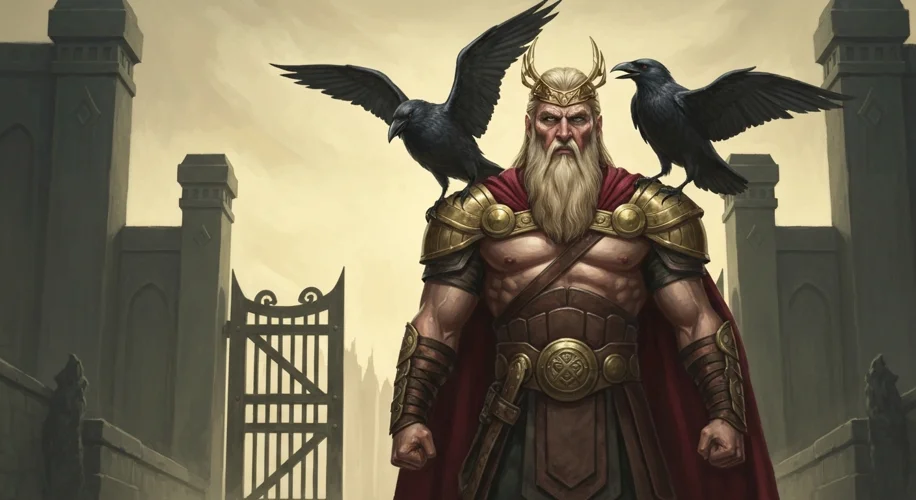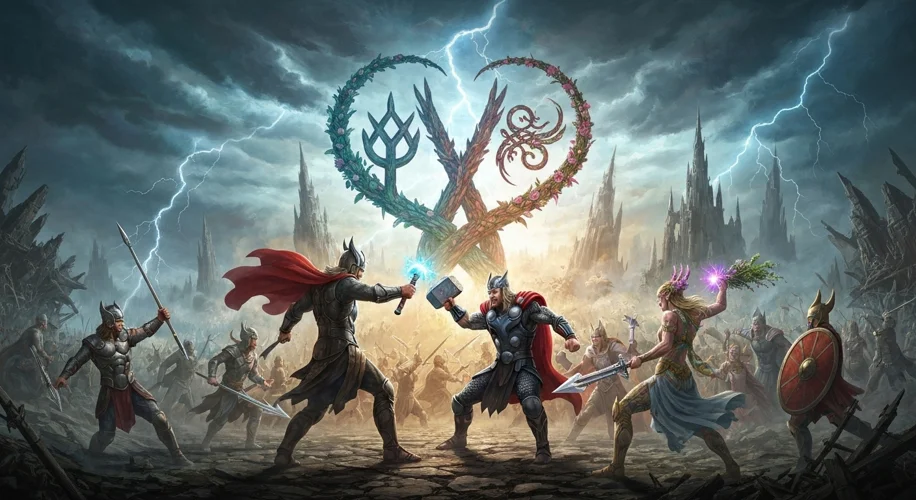The celestial battleground of Norse mythology is often painted with the clash of titans: the Æsir, led by Odin, against the Vanir, associated with fertility and magic. But what if this epic war, narrated in the ancient Eddas, is more than just a divine skirmish? What if it echoes a forgotten historical reality – the uneasy merger of two distinct religious groups or traditions within early Germanic societies?
Imagine the early Germanic peoples, scattered across the rugged landscapes of northern Europe. Different tribes, different beliefs, different ways of appeasing the forces of nature and fate. Over centuries, as these groups interacted, traded, and sometimes warred, their spiritual worlds inevitably began to intertwine. The Æsir-Vanir War, found primarily in the Vafþrúðnismál and Ynglinga Saga, can be interpreted through this lens of cultural synthesis.
The Æsir, often depicted as warrior-gods associated with sovereignty, wisdom, and war, perhaps represented the more established, patriarchal traditions of certain dominant tribes. Think of Odin, the one-eyed All-Father, with his spear Gungnir and his ravens Huginn and Muninn, embodying foresight and the pursuit of knowledge through struggle. Their stronghold, Asgard, is a fortress of power and order.

Conversely, the Vanir, gods like Njord, Freya, and Freyr, are deeply connected to the earth, the sea, prosperity, and sensual pleasures. Njord, god of the sea and wealth, and his children Freya, goddess of love, beauty, and fertility, and Freyr, god of peace, fertility, and sunshine, likely represented the spiritual practices of communities more closely tied to the land, agriculture, and maritime life.
The traditional narrative tells of a conflict born from betrayal. The Æsir, it is said, angered the Vanir by beheading a wise Vanir woman named Gullveig, who was perhaps a priestess or a manifestation of their divine power. This act of violence sparked a war that ravaged both divine realms, with neither side gaining a decisive victory. Eventually, a truce was called, and as a gesture of peace and reconciliation, hostages were exchanged. Odin received Hoenir and Mimir from the Vanir, while the Vanir received Njord and his children, Freyr and Freya.
This exchange of ‘hostages’ is where the historical echo becomes most pronounced. In the context of merging cultures, such an exchange could symbolize the integration of religious leadership and practices. Perhaps the Æsir, through military or political dominance, absorbed the traditions of the Vanir. The arrival of Njord, Freya, and Freyr among the Æsir, and their subsequent respected positions in the Norse pantheon, could represent the successful assimilation of the Vanir cults into the Æsir framework.
Consider the symbolic meaning. The Æsir’s initial aggression against Gullveig (perhaps representing the Vanir’s wealth or influence) could mirror a historical suppression or subjugation of one group by another. The subsequent peace and exchange of divine representatives signify the eventual syncretism, where the distinct elements of both traditions were woven together to form the richer, more complex tapestry of Norse religion as we know it from the Eddas.
This theory doesn’t diminish the mythological richness of the Æsir-Vanir War. Instead, it adds a fascinating layer of potential historical depth. It suggests that the dramatic stories of gods warring and reconciling might be symbolic representations of how human societies, through conflict and cooperation, forged shared identities and spiritual understandings. The Æsir-Vanir War, therefore, could be a divine echo of a very human process: the challenging but ultimately creative fusion of cultures and beliefs.
So, the next time you read of Odin’s spear and Freya’s tears, remember that behind the thunder and lightning, there might be the whisper of ancient peoples shaping their gods, and their gods shaping them, in the crucible of history.

